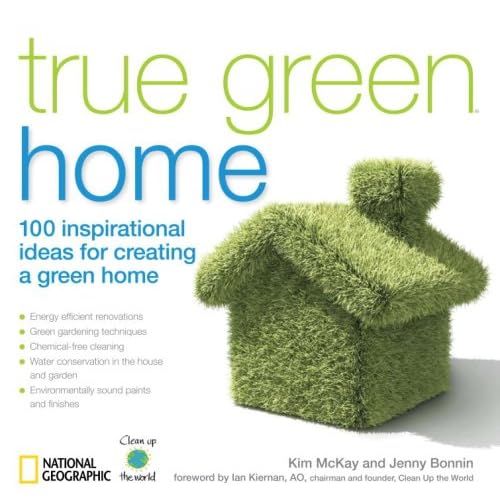 Living a low-impact, eco-friendly life often boils down to simplicity and sheer common sense. Just follow the old proverb “Reduce, Reuse, Recycle,” and you will be a long way towards minimizing your impact on the environment.
Living a low-impact, eco-friendly life often boils down to simplicity and sheer common sense. Just follow the old proverb “Reduce, Reuse, Recycle,” and you will be a long way towards minimizing your impact on the environment.But sometimes consuming less and acting with a green heart still leaves much in the “gray area” of wastefulness and pollution. To help make your life at home as green as can be, Kim McKay and Jenny Bonnin compile 100 great eco-tips in True Green Home. Part of the National Geographic True Green series, True Green Home serves as an accessible introduction to the countless areas of your home that can be either eco-friends or eco-foes.
It is also a great “cheat sheet,” as the authors call it, by combining comprehensiveness with brevity and generality.1 That is, you get a lot of quick glimpses into where your home (or apartment) might be wasting resources and some basic steps you can take to reduce your environmental footprint. (Nearly every page has more space devoted to a photo than words.)
Of course, many of these “inspirational ideas” are next to common knowledge now that “green” has become such a large part of popular culture. You know, stuff like: live close to where you work and shop, use breezes and fans instead of air conditioning, switch to compact fluorescent bulbs.
There are more than just environmental truisms in True Green Home, though. McKay and Bonnin, both leaders in the organization Clean Up the World, manage to serve up some really spicy, juicy tidbits in their smorgasbord of good ideas. Here are a few that I found particularly interesting, surprising, or otherwise noteworthy:
- ”More than 70 percent of discarded computers and monitors and more than 80 percent of TVs become e-waste and are dumped in landfills” (91). Good grief!
- Houseplants are not only attractive but effective green additions to your home, since they freshen air and remove toxins and pollutants (76).
- Garlic is good for more than repelling vampires: mixed with vegetable oil, water, and liquid soap, it makes an excellent non-toxic insect repellent for your garden (117).
- Radiant heat systems, which heats floors, walls, and ceilings, are much more efficient than convection systems (24).
- Windows are responsible for wasting 25 to 35 percent of energy used for heating and cooling in your home (21).
The authors divide these and the other 100 tips in True Green Home into 10 sections, either by location or topic, and precede each section with a case study. These case studies reveal just some of the people, businesses, and organizations that are putting green living principles into practice on the large scale. And since each includes three tips at the end, True Green Home actually contains more than just 100 eco-ideas.
The final section contains resources, including websites for researching some of the topics and methods described in the book--since, after all, True Green Home is not a how-to manual. It also has a glossary of important terms you will surely come across whenever you try to find greener ways to live.
Unfortunately, though, True Green Home does not contain an index, so finding specific topics and ideas can be a bit tricky. The section headings help a bit here, but an index would make this an even handier reference book for your library.
I also found some of the tips rather redundant. How many times and ways can the authors tell us to use natural cleaning products and take advantage of natural light? It sometimes seems like McKay and Bonnin were pushing for the magic number “100” and “recycled” previous tips to make it there.
On the whole, though True Green Home is a valuable way to explore how you can make your habitat a healthier one for you, your family, and the Earth. A quick, enlightening read, this book will inspire you to look at your life more closely, investigate different methods of green living more deeply, and live your human home life more naturally.
Notes
1. Bonnin, Jennny, and Kim McKay. True Green Home: 100 Inspirational Ideas for Creating a Green Environment at Home. True Green Home. Washington, D.C.: National Geographic Society, 2009. 8.







No comments:
Post a Comment